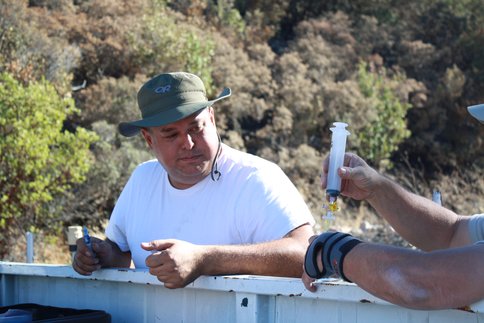2015 Annual Science Report
 University of Colorado, Boulder
Reporting | JAN 2015 – DEC 2015
University of Colorado, Boulder
Reporting | JAN 2015 – DEC 2015
Field Activities at the Coast Range Ophiolite Microbial Observatory (CROMO)
Project Summary
CROMO provides ongoing excellent exposure to samples of ophiolite-hosted serpentinites and associated rocks, access to monitoring wells important for observing serpentinization-related groundwater flow regimes, and serves as a community-building platform that fosters new scientific collaboration. CROMO has served as a test-bed for refining new experimental approaches, and progressing from basic observations to more complex, multi-disciplinary science.
Within the past year, studies at CROMO have focused on the subsurface hydrogeochemical dynamics, by monitoring groundwater hydrology, measuring the concentrations and composition dissolved iron, sulfur, dissolved inorganic carbon, major inorganic anions and cations, dissolved hydrogen, carbon monoxide and methane gases, and organic compounds, in addition to time-series analyses.
CROMO datasets are being incorporated into an exploratory database project aimed at addressing NASA’s public data requirements. Once developed, this database will help to address data sharing plans for collaborators and serve as a valuable tool for CROMO data management across collaborating labs.
In 2015, project members Dawn Cardace, Masako Tominaga, Michael Kubo, Lauren Seyler, Mary Sabuda, Abigail Johnson, Ken Wilkinson, & Cameron Hearne participated in a field trip to CROMO from August 21-27, to continue seasonal bio/geo/chemical monitoring of the wells, as well as assessing the site for future geophysical measurements.
Project Progress
Recent research at the CROMO site has focused on hydrogeological monitoring of the well network, and coordination of a field expedition in August 2015. Pressure-temperature dataloggers deployed within the water table of the CROMO well are providing a near-continuous record of water depth, recharge of the wells, and the impact of environmental perturbations. Within the past two years, the area near CROMO has experienced earthquakes, droughts, wildfires, and floods- and these events are recorded in the well data to varying extents. Information on the hydrology at CROMO provides information both about how the wells are connected to one another, and how they are connected to surface and subsurface (i.e. serpentinization) processes. These data provide a foundation for further studies, including ongoing monitoring of microbiology and geochemistry and new work on geophysical properties.
We have also continued our multi-year monitoring of microbial community diversity and geochemistry at CROMO. These studies allow us to evaluate seasonal effects such as rainfall and recharge that may impact biogeochemical processes at the site. We have expanded these studies within the past year to focus specifically upon iron and sulfur chemistry in the CROMO groundwaters, as earlier data pointed towards the prevalence of taxa which metabolize these compounds. We have also intiated a survey of dissolved organic matter (DOM) composition and variability, in collaboration with the DOE Environmental Molecular Science Lab. The study of natural DOM may provide information on the properties of microbial metabolites, soil derived organic matter, and serpentinization-influenced processes.
Together, the multi-year studies at CROMO have allow us to move beyond basic characterization of this low-temperature serpentinization site to more detailed investigations of the specific properties of the subsurface aquifer. Due to its convenience and accessibility, CROMO also lends itself to experimental manipulations- which form the basis of ongoing work to assess serpentinite-hosted life activity.
Publications
-
Wang, D. T., Gruen, D. S., Lollar, B. S., Hinrichs, K-U., Stewart, L. C., Holden, J. F., … Ono, S. (2015). Nonequilibrium clumped isotope signals in microbial methane. Science, 348(6233), 428–431. doi:10.1126/science.aaa4326
-
PROJECT INVESTIGATORS:
-
PROJECT MEMBERS:
Tori Hoehler
Co-Investigator
Matthew Schrenk
Co-Investigator
Masako Tominaga
Co-Investigator
Caroline Amelse
Collaborator
Abigail Johnson
Collaborator
Mike Kubo
Collaborator
Mary Sabuda
Collaborator
Lauren Seyler
Collaborator
Katrina Twing
Collaborator
-
RELATED OBJECTIVES:
Objective 5.1
Environment-dependent, molecular evolution in microorganisms
Objective 5.2
Co-evolution of microbial communities
Objective 5.3
Biochemical adaptation to extreme environments
Objective 6.1
Effects of environmental changes on microbial ecosystems
Objective 6.2
Adaptation and evolution of life beyond Earth
Objective 7.1
Biosignatures to be sought in Solar System materials
Objective 7.2
Biosignatures to be sought in nearby planetary systems


